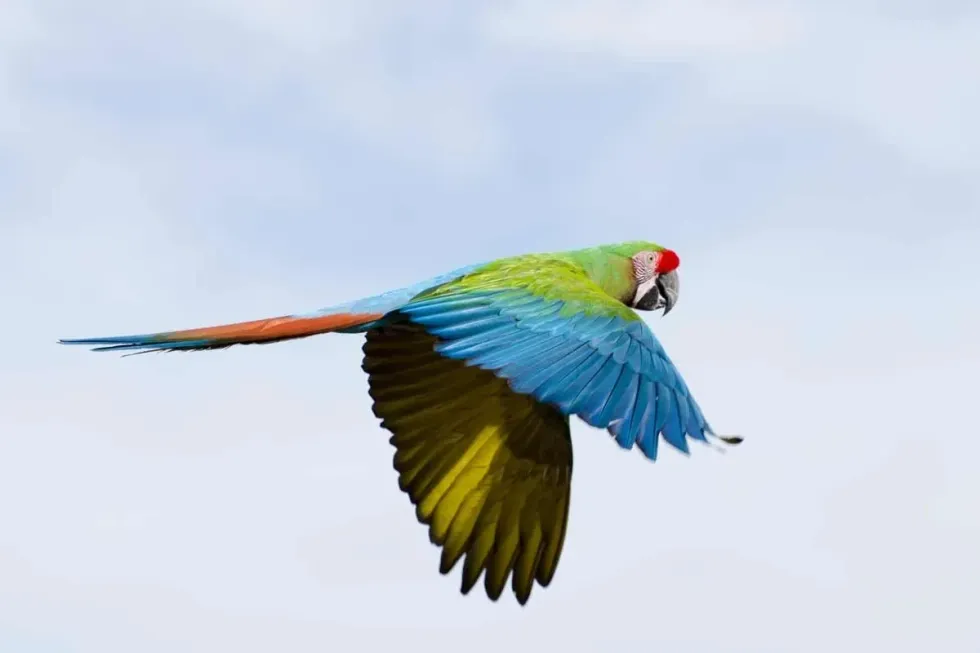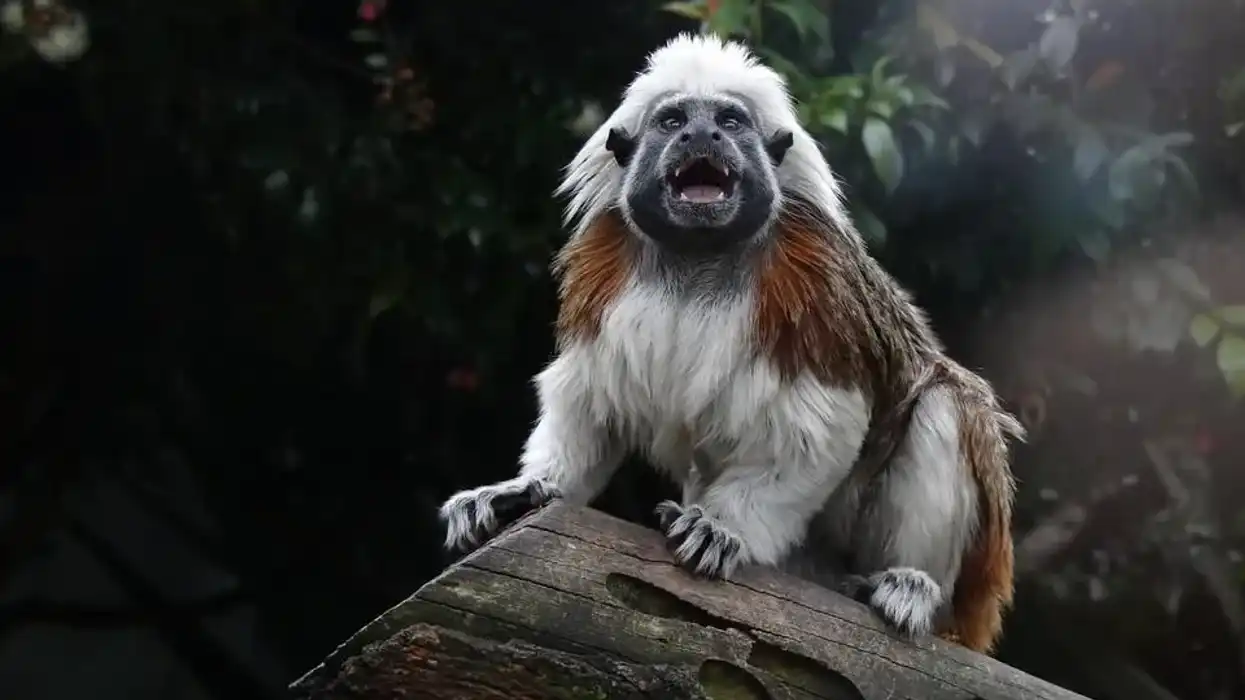Military Macaws are medium-sized parrot species that are known for their attractive and colorful body. The Military Macaw is now on the IUCN red list and is considered an endangered species, with its current conservation status listed as Vulnerable.
This bird is generally found in the Central and Southern parts of America in countries like Mexico and Argentina. These parrots are primarily found in tropical rainforests and montane grasslands.
These parrots (Military Macaws) can live for about 50-60 years in the wild and about 70 years when kept in captivity. These parrots are not small but medium-sized and have a mostly green body along with light blue and yellow flight and red forehead.
They have strong beaks that help them eat nuts, and seeds, and also protect themselves from their predators in the wild.
These animals have amazingly long and colorful tail feathers, which are of great value again. Military Macaws are diurnal and omnivorous birds.
These are not very friendly towards humans but are social birds and are generally seen in flocks. The female lays about two or three eggs once a year and the young ones are taken care of by both their parents.
If you liked reading about these facts, you could also check other facts on bird of paradise and barn owl.
Military Macaw Interesting Facts
What type of animal is a Military Macaw?
The Military Macaw is a bird with features that match a parrot. They are basically parrots who are known for their loud voice, big size, and aggression.
What class of animal does a Military Macaw belong to?
Military Macaws fall under the class of Aves and are birds. They have the ability to fly just as most birds belonging to the class of Aves.
How many Military Macaws are there in the world?
Military Macaws are a vulnerable species of birds. The Military Macaw's (Ara militaris) population has been decreasing at a fast rate in the past years.
With the total population to be estimated around 3000-10000, the number has been going down because of a variety of reasons like habitat loss, pet trade, and hunting. These fascinating birds are included in the IUCN red list.
Where does a Military Macaw live?
Military Macaws are known to live in tropical rainforests and the woods. These birds eat both plants and animals and are dependent on both of them to fulfill their food and protein needs.
The bird is found in parts of South and Central America and also extends its range from Mexico to Argentina. An isolated population is also believed to live between Ciudad Victoria and Ciudad Valles.
What is a Military Macaw's habitat?
The habitat of Military Macaws includes places with water. Places like montane grasslands, deciduous tropical forests, and mountainous regions are the places where these birds generally live.
These birds are omnivores and depend on plants, insects, and snails for food, which are found in good numbers in the above locations. The Military Macaw prefers to live in groups to keep away from predators.
Who do Military Macaws live with?
Military Macaws are very social birds. This parrot species lives in large flocks.
A group of 50 macaws is easy to spot, and they are sometimes seen in groups of 100, too. The Military Macaw is a diurnal animal, it is active during the daytime and rests in the night. These birds are seen flying alone or in pairs too.
While feeding, they gather in small or large flocks in order to eat nuts, seeds, ripened fruits, or other foods that are included in their diet. Military Macaws also live with their mating partners.
How long does a Military Macaw live?
The Military Macaw lifespan is about 50-60 years in the wild. This parrot species have features and body structure that helps it to eat a variety of food items like berries, nuts, seeds, fruits, leaves, insects, and even snails.
Military Macaws live in groups, this helps the bird to keep their predators away.
The only threats to this green bird are loss of habitat and human activities such as the pet trade. Though the bird is known to have a long lifespan in the wild, it can live up to 70 years when kept in captivity.
How do they reproduce?
Military Macaws mate once a year, and the breeding season lasts from January to March. The female lays about two to three white eggs.
The mating pair flies together and stays together. Once the female macaw lays eggs in the nest that is generally built inside a cliff hollow or a tree hollow, she alone incubates the eggs for a time period of 26 days until they hatch, and the male partner must bring food and feed the female.
Once the eggs hatch, both males and females get food like nuts, and seeds to feed their chicks.
The nests are built at heights of up to 200 meters above ground level to keep the eggs safe. The Military Macaw cares intensely for its young ones.
What is their conservation status?
As of now, Military Macaws have a conservation status of Vulnerable, with their population constantly declining because of various natural and human reasons.
Military Macaw Fun Facts
Let us look at some interesting and fun facts about these medium-sized parrot type. Military Macaws are generally heard before they are seen as they have a loud voice, and they communicate by making different sounds based on the situation. Sounds like screams and squawks are commonly heard.
These endangered creatures also make a loud sound like 'kraa-aak'. The body of these birds is primarily olive green in color with black-grey beaks.
This bird gets its unique name from its predominantly green plumage, which resembles a military parade uniform. This endangered species can imitate human voices and even talk. These are considered to be medium-sized parrot species.
What do Military Macaws look like?

The Military Macaw (Ara militaris) are colorful birds. The plumage of the Military Macaw is beautifully green with a yellow and light blue feathers and a bright red forehead with a strong beak. The tail feathers of the Military Macaw are beautiful and worth a lot. This is one of the reasons they are hunted.
How cute are they?
Military Macaws are pretty beautiful as they have a colorful body and are a massive size parrot species. They are not very cute or friendly and are capable of attacking humans, and injuring them if they feel threatened. So as pets, they may not be your best choice.
How do they communicate?
The Military Macaw lives in flocks and makes loud sounds like squawks and screams, which help them to communicate above the forest canopy or cliff faces. These animals have the ability to imitate the human voice, too.
How big is a Military Macaw?
In length, they are 27.5 in (70 cm) long. In height, they are 33 in (83 cm) tall. Their average weight is 1.9-2.4 lb (900-1100 gm)
They are about five times in size and 25 times in weight when compared to a house sparrow.
How fast can a Military Macaw fly?
The Military Macaw's physique allows it to reach a speed of 35 miles per hour(56 km/hour). Though these animals are fairly big in body size, length, and even weight, they still can fly at a decent speed.
How much does a Military Macaw weigh?
These are the medium-sized parrot species found in countries like Mexico and Argentina. The weight of an adult Military Macaw is between 1.9-2.4 lb (900-1100 gm). The Mexican Military Macaw is a subspecies of Military Macaws and is generally bigger than average Military Macaws.
What are their male and female names of the species?
Male and female Military Macaws have no specific names, although they do have names identifying the region they belong to, for example, the Ara militaris mexicana and Ara militaris boliviana.
What would you call a baby Military Macaw?
Like other baby macaws, the baby macaw of this species is also referred to as a chick. Both the parents feed the baby. Military Macaws are known to have a very caring attitude towards their young ones.
What do they eat?
Military Macaws live in groups and pairs. The flocks eat foods like nuts, seeds, fruits, and insects. Military Macaws have large cats, small cats, raptors, and snakes as their predators in the forests andwild.
Are they dangerous?
Military Macaw behavior is very unpredictable and can cause serious injuries to humans if they feel threatened. These parrot species from South America have strong black beaks that help them to hunt, eat and even protect themselves from their predators.
It is capable of biting off fingers, and even snatching an eyeball. The Military Macaw personality shows us that they are not very friendly and can feel threatened quickly.
Would they make a good pet?
Military Macaw as pets is not a good idea as they can be very aggressive and unpredictable. If an animal of this species is being taken care of since young, it might share a friendly bond with the person who feeds them. But as pets, it is not advisable to have one.
Did you know...
The Military Macaw pairs breed for life and build their nest almost 200 meters above the ground. Male macaws feed the females three times a day during the incubation period.
The Military Macaw is not a good family pet.
Being so big, Military Macaws can fly at a speed of 35 mph quickly.
The flocks of Military Macaw contain about 60-70 birds on average.
Military Macaw Subspecies
The Military Macaw has subspecies too, which are the Military macaw ara militaris (1766), Ara militaris boliviana (1908) and Ara militaris mexicana (1915).
Why are Military Macaw cheeks red?
In order to respond to stimuli, the blood vessels in the facial area become active and increases blood flow which makes the Military Macaw blush. This happens when the animal is under stress or excited about something.
What is the difference between a great green macaw and a Military Macaw?
Let us see some differences between the two subspecies of the macaw.
With the Great Green Macaw vs. Military Macaw, the beak of the Buffon's Macaw is bigger than that of the Military Macaw. The Buffon's Macaw has a bigger head than that of the Military Macaw. The Great Green Macaw has a light green overall color, whereas the Military Macaw is much more colorful.
Here at Kidadl, we have carefully created lots of interesting family-friendly animal facts for everyone to discover! Learn more about some other birds, including secretary bird or great green macaw.
You can even occupy yourself at home by drawing one on our Military macaw coloring pages.










